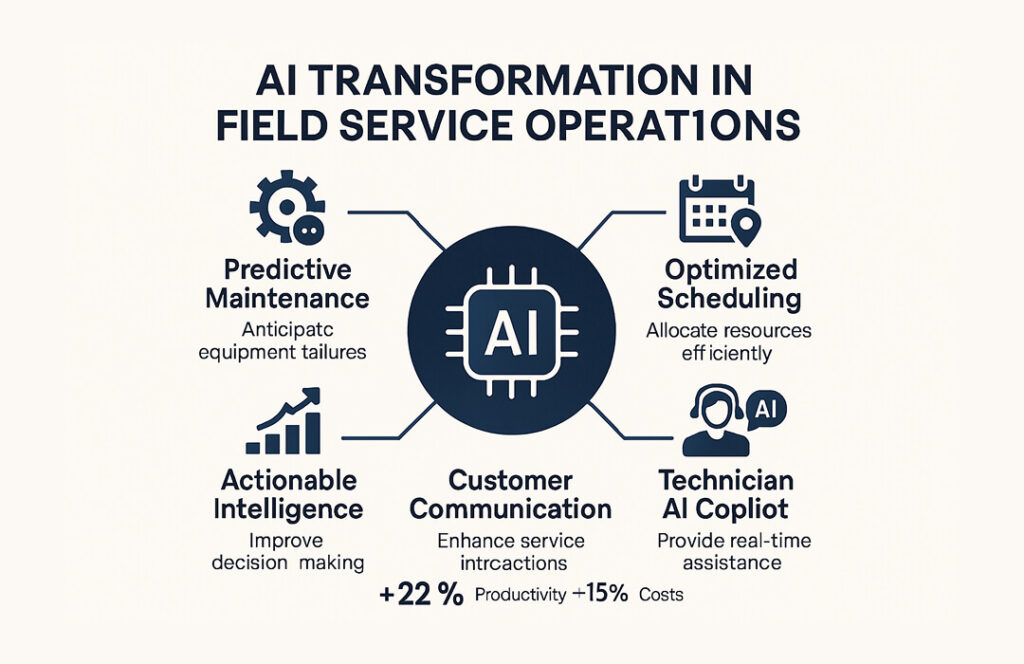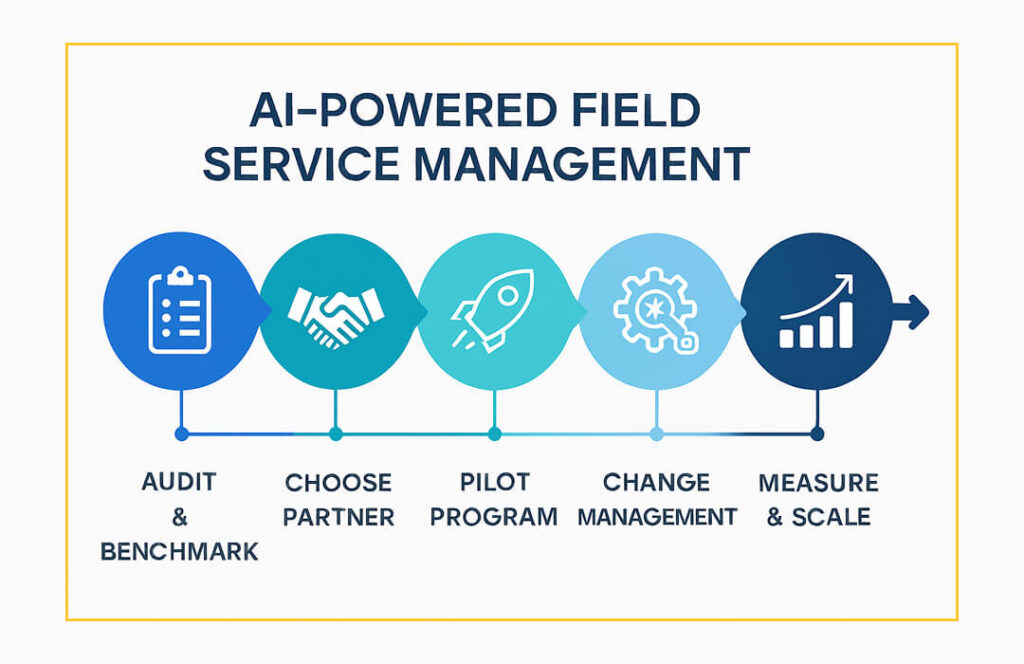Quick summary:
- Explains how AI in Field Service Management shifts operations from reactive to predictive models.
- Emphasizes customer experience benefits: real-time updates, proactive communication, and stronger loyalty.
- Shows how AI scheduling and dispatch reduce delays, fuel costs, and technician stress.
- Highlights predictive maintenance that lowers downtime and extends asset lifespan.
- Covers AI-powered mobile tools that guide technicians, boost first-time fix rates, and streamline reporting.
Downtime is expensive. Studies show that unexpected equipment failures cost companies over $1.4 trillion each year, which is about 11% of global annual revenues. In some industries, even a single hour of downtime can mean losses of more than $300,000, and for asset-heavy sectors like automotive, it can reach into the millions.
This is why field service management (FSM) has become the backbone of operations for industries like manufacturing, utilities, telecom, and healthcare. Yet traditional FSM still relies on manual scheduling, reactive repairs, and scattered data, which often leads to delays, higher costs, and unhappy customers.
Today, the shift toward AI in Field Service Management is changing that story. By using artificial intelligence, companies can predict issues before they happen, send the right technician at the right time, and give customers real-time updates. Instead of firefighting problems, businesses are moving toward a proactive and predictive model that saves money, improves efficiency, and builds trust.
“Stop just managing field service chaos. It’s time to predict, optimize, and master it with AI. Here’s how.”
What is Modern Field Service Management (FSM)?
Field Service Management (FSM) is like the central nervous system of operations. It coordinates everything that happens outside the office, including technicians, vehicles, spare parts, tools, and even customer updates. At its core, FSM ensures the right people, with the right equipment, arrive at the right place and time.
The SaaS Revolution
In the past, FSM relied on on-premise software that was hard to update, expensive to maintain, and difficult to scale. The rise of SaaS field service software changed this completely. Now, businesses use cloud-based platforms that are faster, more affordable, and flexible enough to support teams of any size. This shift allows field operations to be managed from anywhere, with real-time visibility for both managers and technicians.
Key Pillars of Modern FSM
Modern FSM platforms are built on three core foundations:
- Cloud Accessibility – Managers and teams can access job schedules, customer records, and inventory from any device, anywhere.
- Mobile-First Experience – Technicians use mobile field service apps to receive tasks, capture job updates, and even process digital payments on-site.
- Real-Time Data Flow – Data moves instantly between the field and the office, reducing delays, improving accuracy, and giving leaders the insights they need to act quickly.
The AI Leap
If SaaS is the nervous system of FSM, AI is the brain that powers it. By analyzing patterns across thousands of service calls, AI can predict when equipment will fail, automatically assign the best technician, and even guide workers through complex repairs. This makes operations not just faster, but smarter, transforming field service from a reactive process into a predictive and profitable model.
The High Cost of Business as Usual: Why Traditional FSM Fails
Traditional field service management might “get the job done,” but it comes at a hidden cost. Inefficient scheduling, reactive maintenance, frustrated customers, and poor data visibility can drain profits and damage brand reputation. This is why businesses are increasingly shifting toward AI in Field Service Management, which replaces outdated manual systems with predictive insights, optimized scheduling, and automation.
The Domino Effect of Inefficient Scheduling
Field service scheduling is like solving a puzzle, matching the right technician to the right job at the right time. When done manually, mistakes are common. A single wrong assignment can trigger a chain reaction of delays, wasted travel time, higher fuel costs, and overworked technicians. According to research, nearly 25% of field service leaders say scheduling complexity is their biggest challenge, especially when balancing technician skills, job locations, and customer priorities. Modern tools now automate field service dispatch and scheduling, reducing errors and improving efficiency.
The Break-Fix Trap
Most traditional FSM models rely on a “break-fix” approach, waiting until something goes wrong before acting. But reactive maintenance is almost always more expensive. It often requires emergency parts shipping, technician overtime, and extended customer downtime. Studies show that planned, predictive maintenance can reduce costs by 12–18% compared to reactive repairs, and cut unexpected breakdowns by up to 70%. Integrating field service scheduling and dispatch with predictive maintenance ensures technicians are in the right place at the right time, minimizing downtime and costs.
For further insights on how automated dispatching software optimizes routes, scheduling, and service reliability,
read more: How Automated Dispatching Software Solves Fuel Delivery Chaos
The Customer Experience Gap
Customer expectations have changed. People now expect Amazon-level service: real-time updates, accurate ETAs, and proactive communication. Yet traditional FSM tools rarely provide visibility beyond “your technician will arrive today.” This leads to frustration, missed appointments, and customer churn. In fact, 89% of customers say a poor service experience makes them switch to a competitor.
Data Blindness
Field data exists, job reports, customer feedback, parts inventory, but in traditional setups, it’s scattered across spreadsheets, emails, and siloed software. Without a single source of truth, managers struggle to make informed decisions or spot trends. The result? Slow response times, higher costs, and lost opportunities for growth.

The AI Transformation: 5 Ways AI is Creating Smarter Field Operations
AI is no longer just a buzzword; it’s reshaping FSM into a predictive, intelligent, and customer-first system. By combining IoT data, machine learning, and real-time analytics, AI in Field Service Management delivers efficiency gains and cost savings that traditional methods simply can’t match.. Let’s look at the five biggest transformations.
1. Predictive Maintenance: From Fixer to Forecaster
Instead of reacting to breakdowns, AI analyzes IoT sensor data and service histories to forecast failures before they happen. According to Deloitte, predictive maintenance can reduce downtime by up to 50% and cut maintenance costs by 10–40%.
Business impact: Companies move from expensive emergency fixes to planned, low-cost maintenance, extending equipment lifespan and maximizing uptime.
2. Hyper-Optimized Scheduling & Dispatch
AI transforms scheduling into a real-time strategy engine.
- Smart Matching: Assigns the best technician based on certifications, skills, and past performance.
- Route Optimization: Uses live traffic, weather, and job priorities to cut travel time and reduce fuel costs by as much as 20%.
- Dynamic Re-Routing: Reschedules instantly when emergencies arise or technicians are delayed.
Business impact: Teams complete more jobs per day with less stress and wasted travel.
3. Empowering Technicians with an AI Copilot
AI tools act as a copilot in the field, guiding technicians through every step.
- On-the-Go Knowledge: Mobile field service apps provide instant access to repair manuals, schematics, and histories.
- Guided Workflows: AI-driven checklists boost compliance and improve first-time fix rates.
- Remote Assistance: Integrated with AR, senior experts can “see what the technician sees” and guide them remotely.
Business impact: Higher technician confidence, faster resolutions, and fewer repeat visits.
4. From Data Overload to Actionable Intelligence
Field service operations generate mountains of data. AI cuts through the noise by automating analysis.
- Real-time dashboards show KPIs like First-Time Fix Rate, Mean Time to Repair, and Technician Utilization.
- AI detects patterns humans miss, helping managers make data-driven decisions.
Business impact: Faster decisions, smarter resource allocation, and more reliable performance insights.
5. Enhancing Customer Communication with Generative AI
Customer trust depends on clear, proactive communication. Generative AI makes this seamless.
- Proactive Updates: Automatically crafts SMS or emails with live ETAs and status changes.
- Automated Service Reports: Generates customer-friendly summaries instantly after a job.
Business impact: Improved transparency, higher satisfaction, and stronger customer loyalty.

The Tangible ROI: Key Benefits of AI-Powered FSM
Adopting AI-Powered Field Service Features isn’t just a tech upgrade; it’s a proven path to measurable returns. From cutting costs to strengthening customer trust, businesses that leverage AI in field service management are seeing game-changing results.
Drastically Reduced Operational Costs
AI-driven scheduling and smart routing reduce wasted travel, fuel burn, and idle technician time. Studies show companies can achieve up to a 20% reduction in fuel costs and spend 30% less time on travel with AI-optimized dispatch. More jobs get done without increasing headcount.
Maximized Asset Uptime
Predictive maintenance uses real-time IoT data and machine learning to detect problems early. This approach can reduce equipment downtime by up to 50%, keeping operations running smoothly and avoiding costly emergency repairs. The result: extended asset lifespans and higher ROI on capital investments.
Supercharged Workforce Productivity
When technicians have the right job assignments, real-time knowledge, and AI-powered tools, they solve problems faster. Field service organizations report completing more jobs per day with a 25%+ boost in first-time fix rates. That means less rework, happier customers, and higher utilization of your workforce.
Elevated Customer Loyalty
Customer experience is the ultimate differentiator. With real-time tracking, proactive updates, and instant service reports, companies can deliver Amazon-style transparency. This level of visibility builds trust, reduces churn, and increases repeat business.
Future-Proof & Scalable Operations
AI-powered FSM platforms continuously learn from your operations, improving efficiency over time. Whether managing 10 field agents or scaling to 1,000, the system adapts effortlessly. This makes your investment future-proof and ensures your service operations grow in lockstep with your business.

Your Roadmap to AI-Powered FSM Adoption
Implementing AI-powered FSM is more than installing software; it’s a transformation that requires careful planning and execution. Follow these five steps to ensure a smooth adoption and maximize your ROI:
Step 1: Audit & Benchmark
Start by evaluating your current field service operations. Identify your biggest pain points:
- Where are you losing time and money?
- Which processes cause delays or errors?
- What are your current KPIs (e.g., first-time fix rate, mean time to repair, technician utilization)?
A thorough audit provides a baseline, so you can measure improvements once AI tools are implemented.
Step 2: Choose the Right Partner, Not Just a Platform
Select a SaaS field service software provider that understands your industry and offers:
- Robust training and onboarding
- Integration with your existing systems
- A clear, step-by-step implementation plan
The right partner ensures AI adoption is smooth and sustainable, avoiding costly delays or failed deployments.
Step 3: Start with a Pilot Program
Instead of a full-scale rollout, begin with a small pilot group of technicians. This helps you:
- Test AI-powered scheduling, predictive maintenance, and mobile tools
- Gather real feedback from field teams
- Identify areas that need adjustment before scaling
Pilot programs reduce risk and increase buy-in from your staff.
Step 4: Champion Change Management
AI adoption can create uncertainty among your team. Focus on training and communication:
- Show how AI makes their jobs easier, not redundant
- Highlight time savings, reduced manual work, and access to better insights
- Encourage feedback and collaboration to refine workflows
Effective change management ensures your workforce embraces the technology rather than resists it.
Step 5: Measure, Iterate, and Scale
Once the pilot proves successful, expand AI tools to the entire team. Continuously monitor KPIs to track improvements and uncover new opportunities:
- Evaluate productivity gains, downtime reduction, and first-time fix rates
- Identify additional areas for optimization
- Iterate on processes and AI configurations to maximize impact
A structured, data-driven rollout ensures your AI-powered FSM investment delivers measurable results and supports long-term growth.
Achieve Smarter Field Service Today with Clarro
Modern field service management requires more than reactive tools; it demands intelligence, efficiency, and real-time insights. Clarro’s AI-powered FSM platform and SaaS workforce management platform directly address the challenges of traditional field service, transforming operations from reactive to predictive.
Clarro’s Predictive Engine
Our AI continuously analyzes asset data and historical trends to detect early warning signs before equipment fails. By turning potential problems into actionable alerts, teams move from firefighting to proactive maintenance, reducing downtime and extending asset life.
Clarro’s Smart Dispatch AI
Scheduling and dispatching are fully automated, factoring in 20+ variables, including:
- Technician skills and certifications
- Real-time traffic and weather
- Parts availability and location priority
This ensures the right technician is assigned to the right job at the right time, optimizing routes, cutting fuel costs, and improving overall operational efficiency.
Clarro’s Mobile Copilot for Technicians
Technicians gain a true field assistant in their pocket:
- Instant access to knowledge bases, repair manuals, and service histories
- AR-guided remote support for complex tasks
- Automated reporting tools for faster documentation and compliance
This empowers technicians to resolve issues faster, improves first-time fix rates, and reduces the need for repeat visits.
Business Impact with Clarro
Companies that adopt Clarro see measurable results quickly:
- 22% increase in productivity within the first six months
- 15% reduction in operational costs due to optimized scheduling and predictive maintenance
- 30% boost in customer satisfaction scores, thanks to proactive communication and faster service
By combining predictive intelligence, smart dispatch, and mobile empowerment, Clarro transforms field service operations, helping businesses save costs, enhance productivity, and deliver superior customer experiences.
Conclusion
The shift from manual, reactive field service to an AI in Field Service Management-powered, predictive model is no longer a concept for the future; it’s a competitive necessity today. Businesses that continue relying on traditional FSM face higher costs, inefficiencies, and frustrated customers, while those embracing AI-powered FSM gain smarter scheduling, proactive maintenance, and better overall performance.
Inefficient operations are no longer unavoidable. With AI-driven tools like Clarro, companies can transform field service into a strategic advantage, improving productivity, customer satisfaction, and profitability.

(FAQs)
Q1: Will AI replace my dispatchers and technicians?
No. AI is designed to augment their abilities, not replace them. By automating manual scheduling and routine tasks, dispatchers can focus on high-value activities like customer interactions and exception handling. Technicians become more effective with AI-guided tools and mobile field service apps, improving first-time fix rates and overall productivity.
Q2: What kind of data do I need for AI FSM to work?
You can start with basic operational data, such as job histories, technician skills, and asset details. The more data you provide, including IoT sensor readings, the more powerful the AI predictions become. Modern platforms like Clarro deliver value from day one, even with limited data, and improve insights as more information is collected.
Q3: How long does implementation take?
With modern SaaS-based FSM platforms, a pilot program can be operational in weeks, not months. The key is a phased rollout, starting small, gathering feedback, and gradually scaling, so teams can adapt quickly and measure early ROI.
Q4: Is AI in FSM only for large enterprises?
Not at all. SaaS-based AI-powered FSM platforms are affordable and scalable, making them accessible for businesses of all sizes. Smaller teams can compete with larger companies by leveraging predictive maintenance, smart dispatch, and mobile AI tools to boost efficiency and customer satisfaction.




